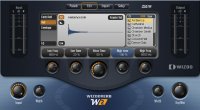Rode NT2-A
Good evening from a rain soaked Pennsylvania
Today I spent some time working on a project that has been in process for over 6 years now. Yep, and you thought the new Guns n Roses album was taking forever...oh wait, that's taking 10 years. Never mind.
Anyway, it's the debut album from my talented and bi-lingual brother, Josh Blakesley. It's going to be a great album. He writes great songs, has an excellent voice, and an ear for beautiful harmony. We're hoping to finish in time for a Christmas release.

So anyway, we were just about to lay down some vocals when I hear a loud thump on my doorstep and off I ran to see if it was what I hoped it was. It was!! My new Rode (or RØDE depending on how you want to type) NT2-A large diaphragm condenser microphone was just outside my front door. I love getting new gear and getting a new mic is just about as exciting as it gets. No time to waste, I ripped open the box and had the NT2-A set up in no time and ready for a trial by fire.
The first thing I noticed was how big and heavy this thing is. I've spent too much time recently working with Chinese manufactured mics; I almost forgot what real quality feels like. These mics are made in Australia and the NT2-A is an update on the tremendously popular NT2 (which coincidentally I think was made in China). After I figured out the funny mic clip and made a change to the only mic stand I have that has one of those really tiny screw connectors, I fired up the phantom power, put the mic in cardiod mode and let 'er rip.
What a transparent sounding mic! No EQ, just a bit of compression, and viola! Great sounding vocals. The mic is very quiet and has an even frequency response across the board.
As for specs, I won't bore you with the typically stuff like 20-20k freq response. You can get that from the Rode website. The features are very nice and include three polar patterns: omni, cardiod, and figure 8. Hi-pass filter selectable at 40, 80, or off, and a pad selectable at 0, -5db, or -10db. All in easy to use FINGER SWITCHABLE switches on the front of the mic. You heard me right, you don't need to stick a pen anywhere to make these switches. Just use a normal human finger and you're fine. Score 1 for Rode. It amazes me sometimes that the most obvious things are the most overlooked by companies. So thank you Rode for being Captain Obvious.
After recording that lead track we worked on a part that required both of us singing together in close harmony. What better opportunity to try out the figure 8 setting? This was the first experience for either of us singing in this fashion and we found it a bit uncomfortable being that close face to face while singing. We have a problem of laughing whenever we look at each other. But we made it though and found the recording to sound very natural and we were able to blend our voices nicely by being so close. Plus we felt like George Harrison and Paul McCartney while doing it. :-)
Next I was tracking my brother and his wife singing together for a song of my own where there will be a large group of people (about 22 different voices) singing together although they are all recorded separately. For this I thought I'd try out the omni pattern and get a bit of room sound. As expected this opened up the sound quite a bit and gave a little boost at around 10kHz for a pleasant and airy effect.
That's all the time I had to work with the NT2-A today, but I have to say, I love it so far. My only complaints are with the stand adapter as it's cumbersome to set up and to change positions, but I suppose going forward I'll just use a shock mount instead.
Worth every bit of the $399 price tag and probably quite a bit more.
Listening to Greg Brown Slant 6 Mind. A very cool, chill kind of album. I hope to make a record like this soon. Far enough to the folk side of blues that it works for a white guy to make it.
Rock on
Ben
www.javboyrecords.com
UPDATE: I just used the NT2-A as a room mic for drums and it sounds fantastic all by itself! If I was going for mono drums I wouldn't use any of the other tracks I recorded. I set it up about 5 feet from the kit and 3 feet off the ground. It was in omni mode with the -10dB pad engaged. From there I went into the Joemeek ThreeQ (see previous post) with the compression set to 3, attack at 5, and release at .3. The EQ was not active. I love it when new gear sounds good.



